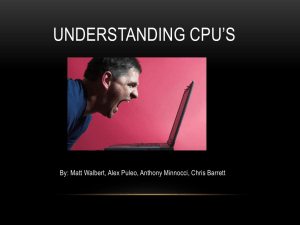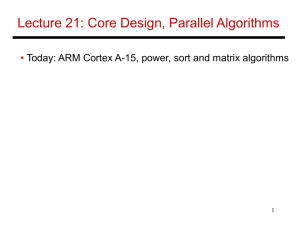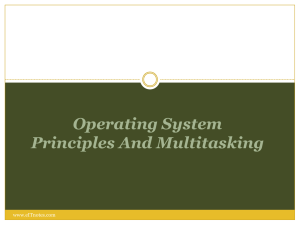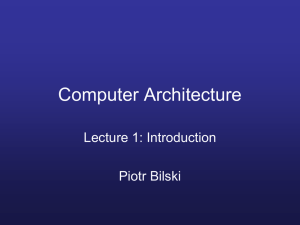Understanding CPU`s
advertisement
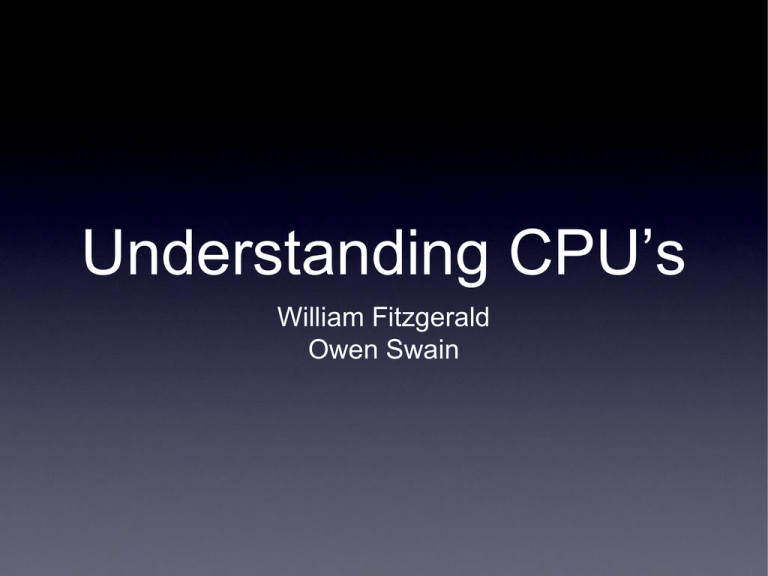
Understanding CPU’s William Fitzgerald Owen Swain CPU Basics • The CPU is considered the “brain” of the computer. • It fetches instructions from memory and executes them. • It runs the operating system and applications, constantly receiving input from the user or active software programs. CPU Basics • • • • Modern CPU’s are small and square with many short, rounded, metallic connectors on its underside. CPU attaches directly to a CPU “socket” (also called a “slot”) on the motherboard. It is inserted pin-side-down and a small lever helps to secure the processor. After running for even a short while, CPUs will get very hot • To dissipate the heat, it is necessary to attach a heat sink and a fan directly on top of the CPU. Pins are used on the bottom of the CPU to connect to the motherboard A heat sink and fan must be placed on top of the motherboard to prevent overheating Components • • • Arithmetic logic unit (ALU): performs simple arithmetic and logical operations. Control unit (CU): interprets instructions from memory and converts them into signals to activate other parts of the computer. Cache, which serves as high-speed memory where instructions can be copied to and retrieved. Transistors • • • • To carry out ALU calculations, computer codes made up of zeros and ones are stored inside a processor through the use of transistors Transistors: Switches, which turn on and off to control the flow of electricity; this generates binary code A one is created if current passes through and a zero if a current does not pass through. A single CPU includes several hundred million transistors • • • • • Troubleshooting: Symptoms A failing CPU could be indicated by: The Computer not booting, or operating system unable to load No display PC may crash on startup or when running particular software The PC may lock up after startup. Overheating • A computer locking up on startup can be an indication of overheating • Dust is a major factor, it is a thermal insulator, meaning that the heat will build up in the CPU because of it • Check the temperature of your Computer, a larger or additional fan may be needed if it is too hot. • Clogged vents Other CPU Issues • • • BIOS issues: Older BIOS can have problems with newer CPU, go to manufacturers website and install a new bios. Installation issues Make sure the CPU is seated flatly, make sure the CPU cannot fall out Orientation: make sure that the CPU is oriented to the correct sockets, make sure the pins match up in the CPU and the socket • No Display: The computer will turns on but system does not start up; the common cause of this is the wrong bus speed, you will have to reinstall the correct CPU in this scenario Troubleshooting • • • • CPUs usually do not wear out under normal circumstances Overall, CPUs are difficult to troubleshoot because they are not mechanical CPUs are very difficult for an average person to repair If a CPU is malfunctioning it must be replaced; Test with another CPU first before replacing A+ CPU Facts When selecting a CPU be aware that you will need to match the motherboard and CPU. Either select a CPU supported by the motherboard, or select a motherboard that will support the processor you have chosen. The following should be considered when selecting a processor: Hyper-threading Manufacturer • • • • • • 32-bit or 64-bit Speed Multi-core Cache Process Size • • • • • • Throttling Mobile Processors Virtualization Integrated memory controller Cooling Manufacturer • Intel and AMD are the two producers of processors used in modern PCs. • Both work in PC systems and support Windows software. • Intel has a larger market share, while AMD processors generally cost less. • Processor performance and special features vary between models and manufacturers. 32-bit • • • • Can hold 32-bits of information at a time. Limit of 4GB. Use the IA-32 instruction set (also referred to as x86). 64-bit • • 32-bit applications can run on 64-bit processors using these methods: • • Itanium processors (Intel) use a software layer to translate between IA-32 and IA-64. ADM64 and Intel 64 processors execute both 32and 64-bit instructions in hardware. • • Can hold 64-bits of information at a time. Theoretical limit of 16.8TB, although operating system and and hardware limitations impose a lower practical limit. OS and applications must be written for 64bits to take full advantage of 64-bit processor. Applications typically perform better on 64bit systems. Speed • Processors operate using an internal clock that is the same as, or is a multiple of, the motherboard bus speed. Speed is represented in MHZ and is also referred to as frequency. • • • You can purchase processors of the same type but with different speed ratings. When selecting a processor, make sure motherboard supports the processor speed by reading the motherboard documentation first. Most motherboard automatically detect processor speed. If not, you might need to use jumpers or edit the CMOS to sonfigure processor speed. Multi-core • Multiple core processor has multiple processors within a single processor package. • • • • Dual-core, triple-core, and quad-core processors are typical in desktop systems. Multi-core systems allow OS to run multiple apps at once. Without multiple processors, apps appear to run at the same time, but must wait their turn for processing time from th single processor. Some apps can be written to execute on multiple processors at the same time. Some motherboards use two (or more) processor sockets to provide a multiple processor solution. Multi-core processors use a single motherboard socket to support multiple processors. Cache • Cache is memory that the processor can access directly without the system RAM. There are three types: • • • Level 1 (L1) is integrated on processor die itself and store instructions for processor. On multi-core systems, each processor has its own L1 cache. Some may have two, one for instructions and one for data. Level 2 (L2) is additional cache used for both instructions and data. Depending on processor, L2 cache may be shared between two or more cores, or exclusive to single core. Level 3 (L3) is additional cache beyond L2 cache. For multi-core systems, L3 cache is shared between all cores. Cache • Be aware of the following regarding cache. • • • Size of cache increases as you move from L1 to L3, with L1 being smallest. A processor with more cache performs better than one with less. Originally, only L1 cache was located on the processor die, with L2 being on motherboard between CPU and RAM. As technology has advanced, L2 cache moved to processor die, with L3 on the motherboard. Now, all three are located on the processor. Process Size • Refers to the manufacturing process used to etch transistors on silicon wafer that become the CPU. Smaller process size means smaller transistors, which translates to smaller CPU die with more transistors and less power consumption. Process size is expressed in microns or nanometers. Hyper-threading • • A feature of some Intel processors that allows a single processor to run threads in parallel, as opposed to processing threads linearly. Hyperthreading enables a processor to execute two threads at once. For example, on a quad-core Intel system that supports hyper-threading, the processor can execute 8 threads at a time. Not the same as multi-threading. Multithreading is a feature of an app that allows it to send multiple threads at the same time. Apps are typically written to support multithreading to take advantage of multiple cores or hyper-threading features. Throttling • Process of modifying the operating characteristics of a processor based on current conditions. • • • • Often used in mobile processors to change the operating frequency to minimize power consumption and heat output. Can be used in low memory conditions to slow down the processing of I/O memory requests, processing one sequency at a time in the order the request was received. Processors or the operating system can shut down unused cores in multi-core systems to conserve energy. Some Intel processors use a Turbo Boost feature. The opposite of throttling, Turbo Boost allows the processor to dynamically run above its rated speed to improve performance. Mobile Processors • Used in notebook computers where portability and mobility are a concern. Special versions of processors are built to minimize power consumption and the amount of heat generated. Virtualization • Allows a single physical machine (known as host OS) to run multiple virtual machines. The virtual machines appear to be self-contained and separate physical systems. • • • • Performed by adding a layer between physical system and OS. This layer acts as the guest system. Early virtualization was performed using software only. Newer virtualization uses special instructions to supported by processor to improve performance. VMware is most popular virtualization solution. Microsoft has several including Virtual PC, Virtual Server, and Hyper-V. If you plan on using virtual solution, see if hardware support in CPU is required. Hardware support is provided by processors with following features: • • Intel’s Virtualization Technology (VT) AMD’s AMD Virtualization (AMD-V) Integrated Memory Controller • In traditional processor design, the processor is connected to front side bus and Northbridge chip. Processor communicated with other system components through front side bus. Smaller manufacturing size has reduced overall size of the processor, leaving more room on processor die for additional cores or cache. Some processors include memory controller on processor die rather than in Northbridge chip, resulting in faster memory access by processor. Cooling • Processors require some form of heat dissipation system to function properly. Without a dissipation system, a processor will overheat and burn up in less than a minute. Most modern CPUs require a heat sink and a fan. Between CPU and the heat sink, thermal paste or thermal pad helps in the transfer of heat from CPU to cooling unit. Performance Facts For a long time, processor clock speed was used as a measure of processor performance. This is not true of newer processors because: • • • • • If two processors are of same type, higher speed typically means higher performance. Its important to make sure the motherboard can support the speed of your processor. Many processors use a performance rating instead of speed with a higher number indicating a better-performing processor. However, performance ratings are typically only applicable between models of the same manufacturer. In some cases, buying a processor with double cache can nearly double the performance. Dual core processors offer better performance, but typically do not double. • • • Special instruction sets supported by a processor can increase performance. Example: Hyper-threading support on Intel processors can boost performance for specific types of operations. Performance can be increased by modifying other system components such as adding more RAM, using a faster disk, or improving cooling or ventilation. Overclocking is a feature that causes the processor to operate at a higher speed. Overclocking is performed by those who want to get the maximum performance from their systems. • • • • Overclocking can cause system instability, component famage, and can void your warranty. Motherboard bus, processor, and memory setting shuld eb adjusted. Overclocking may require more voltage. Overclocking increases heat output. May be necessary to upgrade your cooling devices. CPU Socket Facts • • • Ensure motherboard is compatible with system CPU that you intend to use. Motherboard socket must match the socket of your processor. Some motherboard accept multiple processors and will have a socket for each one. Processor sockets can be categorized according to how the processor makes contact with the leads in the processor socket: • • Pin Grid Array (PGA) implement a series of pins on the underside of the processor package in an array. The pins are inserted into corresponding receptacles within the processor socket on the motherboard. Land Grid Array (LGA) socket moves connecting pins from processor package to the socket itself. Conducting pads are implemented on the bottom of the processor that contact the protruding pins from processor socket. • • Some commonly implemented sockets include: Intel • • • • 775: Used with Intel Pentium 4, Celeron D, Intel Pentium 4 Extreme Edition, Pentium D, Pentium Dual-Core, Core 2 Duo, Core 2 Extreme 1155: Used with Intel Pentium 4, Celeron, Core i3, Core i5, Core i7, Core i7 Extreme, and Xeon processors. 1156: Used with Pentium 4, Celeron, Core i3, Core i5, Core i7, and Xeon proessors. 1366: Used with Intel Celeron, Core i7, and Xeon processors. • AMD: • • • • • • • 940: Used with AMD Opteron and Athlon 64 FX processors. AM2: Athlon 64, Athlon 64 X2, Athlon 64 FX, Opteron, Sempron, and Phenom processors. AM2+: Used with Athlon 64, Athlon 64 X2, Athlon II, Opteron, Phenom, and Phenom II. AM3: Used with Phenom II, Athlon II, Sempron, and Opteron. AM3+: Used with Phenom II, Athlon II, Sempron, and Opteron processors. FM1: Used with Athlon II processor along with A-series APUs. F: Used with Opteron and Athlon 64 FX. CPU Installation Facts Intel Chip: CPU is installed in the Socket 775 connector AMD chip: install the processor into the white square labeled Socket AM2 Connector https://www.youtube. com/watch?v=vLVHF aokdgA More Resources • • • http://www.geek.com/desktop-computerbuyers-guide/cpu/ http://educationportal.com/academy/lesson/centralprocessing-unit-cpu-parts-definitionfunction.html#lesson http://www.youcanbuildyourowncomputer. com/installprocessorcpu.html
